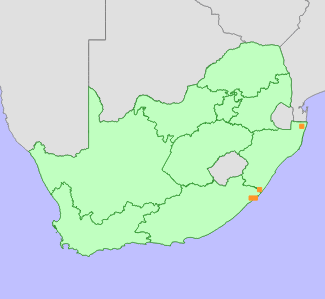|
Scientific Name | Cyathocoma bachmannii (Kük.) C.Archer |
Higher Classification | Monocotyledons |
Family | CYPERACEAE |
Synonyms | Tetraria bachmannii Kük., Tetraria thuarii in sense of C.B.Clarke var. gracilior C.B.Clarke, not of P.Beauv. (misapplied name) |
National Status |
Status and Criteria | Vulnerable B2ab(iii,v) |
Assessment Date | 2013/07/23 |
Assessor(s) | L. von Staden |
Justification | A widely distributed (EOO 21 500 km²), but very rare species, recorded from only a few, isolated sites (AOO estimated <200 km²). It is known to occur at five locations, but is suspected to occur at up to 10, as much of this species' range is poorly explored. It continues to decline due to ongoing habitat loss and degradation. |
Distribution |
Endemism | South African endemic |
Provincial distribution | Eastern Cape, KwaZulu-Natal |
Range | Maputaland to Port St Johns. |
Habitat and Ecology |
Major system | Terrestrial |
Major habitats | Pondoland-Ugu Sandstone Coastal Sourveld, Maputaland Coastal Belt |
Description | Wet to damp heavy black soils on the margins of streamlets or isolated wetlands. |
Threats |
| This species is endemic to South Africa's most threatened biome, Indian Ocean Coastal Belt. Less than 50% of natural vegetation remains intact, and continues to decline rapidly. Within the northern part of this species' range, coastal grasslands have been predominantly converted to timber plantations, and remaining natural areas continue to be lost to expanding settlements and subsistence agriculture. This species has bot been recorded in the coastal belt between Maputaland and Pondoland, however this area is also extensively and irreversibly modified predominantly to sugarcane plantations. Within the Pondoland region, the southern part of this species' range, habitat loss and degradation due to overgrazing and expanding human settlements and subsistence agriculture is also ongoing. |
Population |
A rarely collected habitat specialist, known from only few, isolated collections, but recorded as locally abundant in these sites. The southern part of this species' range falls within the Pondoland region, which due to its inaccessibility is one of South Africa's botanically most poorly explored areas. This species has however been collected in all the well-collected sites within Pondoland such as Umtamvuna Nature Reserve, Mkambati Nature Reserve, as well as around Port St Johns, indicating that it is also likely to occur in under sampled areas in between. The KwaZulu-Natal Coast, which forms the northern part of this species' range is better sampled, however, it is also >90% irreversibly modified, with little or no suitable wetland habitat remaining. More surveys are needed to verify the number of existing subpopulations.
|
Population trend | Decreasing |
Assessment History |
Taxon assessed |
Status and Criteria |
Citation/Red List version | | Cyathocoma bachmannii (Kük.) C.Archer | VU B2ab(iii,v) | 2014.1 | | Cyathocoma bachmannii (Kük.) C.Archer | Least Concern | 2013.1 | | Cyathocoma bachmannii (Kük.) C.Archer | Least Concern | Raimondo et al. (2009) | |
Bibliography |
Abbott, T. 2006. The story of the Pondoland Centre. PlantLife 33&34:5-72.
Archer, C., Browning, J. and Gordon-Gray, K.D. 1997. Studies in the Cyperaceae in southern Africa 31: a third species of Cyathocoma, C. bachmannii. South African Journal of Botany 63(4):167-171.
Gordon-Gray, K.D. 1995. Cyperaceae in Natal. Strelitzia 2:1-218. National Botanical Institute, Pretoria.
Kükenthal, G. 1940. Vorarbeiten zu einer Monographie der Rhynchosporoideae IX. Feddes Repertorium 48:195-250.
Raimondo, D., von Staden, L., Foden, W., Victor, J.E., Helme, N.A., Turner, R.C., Kamundi, D.A. and Manyama, P.A. 2009. Red List of South African Plants. Strelitzia 25. South African National Biodiversity Institute, Pretoria.
|
Citation |
| von Staden, L. 2013. Cyathocoma bachmannii (Kük.) C.Archer. National Assessment: Red List of South African Plants version 2024.1. Accessed on 2025/11/17 |
 Comment on this assessment
Comment on this assessment


